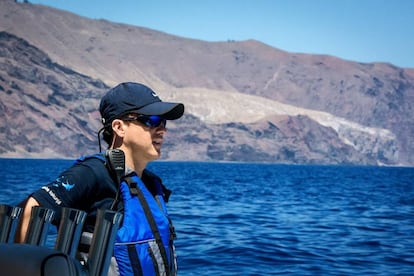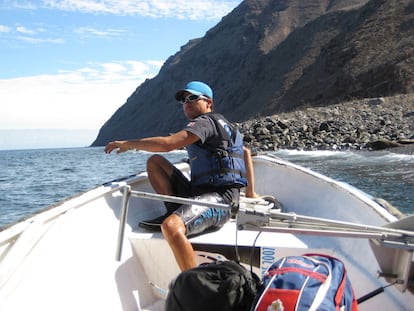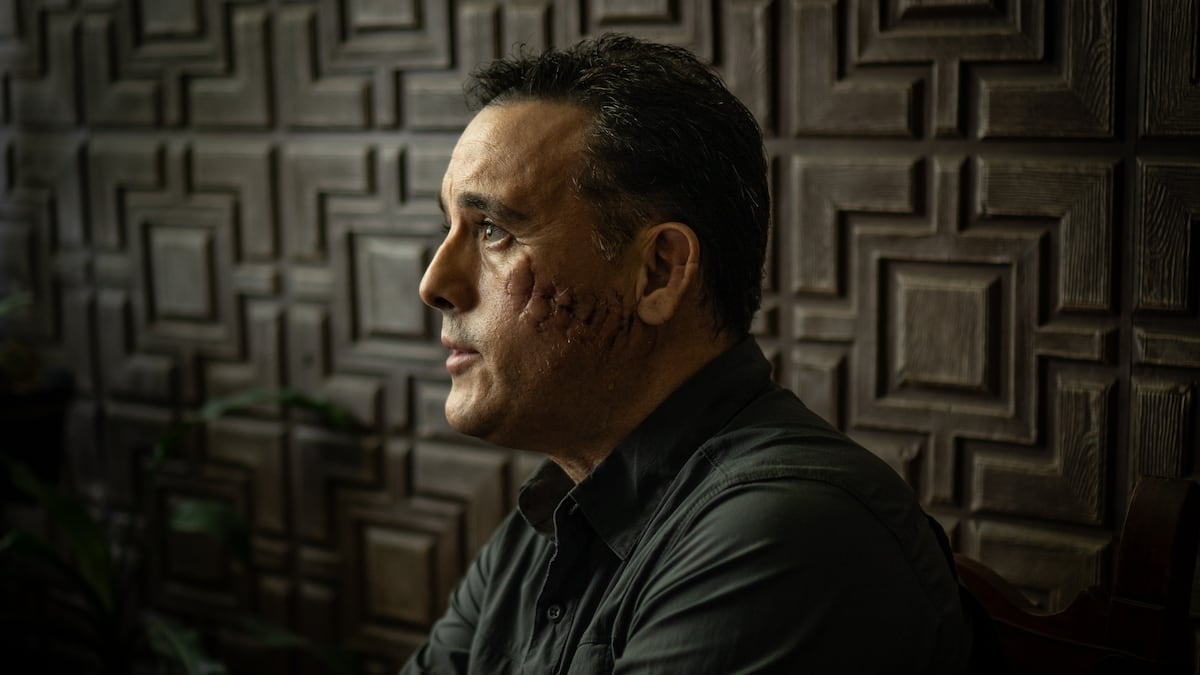No film has done more damage to an animal’s reputation than Steven Spielberg’s Jaws. It premiered in the summer of 1975, but the fear it instilled in people remains rife 50 years later. For the marine biologist Mauricio Hoyos, however, it had the opposite effect. “It made me fall in love with the great white shark and dedicate my life to working with these incredible animals,” admits the Mexican scientist, who receives this reporter at his mother’s house in Mexico City, where he is recovering from the serious accident he suffered a few weeks ago in Costa Rica waters.
Hoyos, who normally resides in La Paz, on Mexico’s Baja California peninsula, had traveled to the Cocos Islands as part of the One Ocean Worldwide Coalition to conserve the oceans and their biodiversity. The goal of the expedition was to implant markers on hammerhead sharks to track their local movements and migrations, map their habitat coordinates, and monitor their populations, which have been drastically reduced worldwide in recent decades. This activity is fundamental to their protection and is part of the biologist’s routine, having carried out some 2,000 taggings throughout his career.
Armed with his Hawaiian sling, a fishing spear with a special tip, he had just tagged a nearly four-meter-long female of the Galapagos species and was preparing to record its data on a tablet when he received a bite that nearly cost him his life. He says the specimen had caught his attention because of its size, “so when I saw it swimming toward the bottom, I went after it. I oriented myself toward it and shot it at the base of its dorsal fin, where it has the thickest muscle layer and it doesn’t hurt as much.”
But the animal reacted to the sting, turned around, and that’s when it all happened. “Out of the corner of my eye, I saw it turn toward me, and my immediate reaction was to lower my head. Suddenly, my head was inside its mouth. It was incredible; I felt the pressure of the bite; my skull crunched!” he recounts.
 The attack occurred after a trip to the Cocos Islands to promote ocean and biodiversity conservation.
The attack occurred after a trip to the Cocos Islands to promote ocean and biodiversity conservation.
On the left side of his face, the striking scars from the accident are quite visible: marks from the 29 teeth the shark sank into him. “An inch higher, and it takes your eye; an inch lower, and goodbye to your neck,” the surgeon told Hoyos. “It was a defensive bite. If it had been an attack, I wouldn’t be here,” he explains, having dedicated 30 of his 48 years to studying the behavior and reproduction of these ocean creatures, which are among the largest and most endangered in the world.
“She spared my life”
Contrary to popular belief, experts have been demonstrating for years that sharks only tend to attack as a self-defense reflex. “My head was inside her mouth; I was the most vulnerable animal at that moment, and all she did was bite and let go,” the biologist explains. As he explains, when sharks want to kill their prey, they sharply twist their heads. “Their teeth are designed to sever. They bite first and then shake their heads sideways. She could have killed me instantly, but she didn’t. She spared my life.”
From that moment on, time began to tick in slow motion. In the attack, the animal ruptured the air supply hoses, which released air at full pressure. “That scared her,” says Hoyos, who never lost his composure in the situation. “I knew I was in danger, but I knew what I had to do,” he says. His knowledge of shark behavior, knowing the animal wasn’t trying to attack him, and more than three decades of diving experience were key factors in his survival.
Normally, the marine biologist doesn’t dive deeper than 20 meters. But he’d been asked not to dive while there were tourist activities going on. “The only time it was possible was at 1 p.m., when the animals swim very deep, down at 40 meters,” he says.
The scientist only planned to stay at that sea level for a few minutes. But that was the moment the incident occurred. The hose through which he was breathing was no longer giving him air, so he hurriedly grabbed the octopus, the equipment’s emergency tube. And he began to ascend slowly.
“At those depths, you can’t hold your breath when you ascend, because when the pressure drops, the gases expand and the lungs or pleura can explode,” he explains.
Between the water that had entered his mask and the amount of blood, he could barely see when the midday light appeared like a flash, and with it, the enormous shadow of the female that had bitten him. “She circled around me twice, but didn’t do anything to me. That’s why, I insist, if it had been an attack, she would have followed me and finished me off. She had the strength and the power for it,” he emphasizes.
On the surface, the boat captain was waiting for him and quickly helped him remove his equipment. “When he saw me, he stood there staring for about 10 seconds without saying anything, in shock. I imagined my face had been lost; it felt torn apart,” says the biologist, while placing a hand over his stitched left ear.
After removing his mask, blood began to flow freely. “They say that when sharks smell a single drop of blood, they go into a feeding frenzy, they go crazy. I didn’t stop bleeding from 40 meters down and all the way to the surface, and that female didn’t follow me to eat me. Because we are not part of the marine ecosystem’s menu, our blood has other components that the prey they normally feed on don’t have,” says Hoyos.
 Mexican marine biologist Mauricio Hoyos.Nayeli Cruz
Mexican marine biologist Mauricio Hoyos.Nayeli Cruz
The accident he suffered is the first incident he’s had with one of them. “Between biopsies and tagging, I’ve used the tagging tool thousands and thousands of times and with various species: great white sharks, which can reach five meters, with silver tips, and even with bull sharks, which have the strongest bite of all compared to their size. Normally you tag them and they swim away,” he underscores. The only ones that have ever reacted differently, he says, are the Galapagos sharks, “although I’d never been bitten before. They are very large and dominant animals.” And what they usually do, he explains, “is lower their fins and hunch over to show that they’re not happy with your presence.”
That was precisely the reaction the female had toward the other diver accompanying Hoyos that morning, and who was able to observe the entire scene. “After biting me, she charged toward him threateningly, and left,” the scientist recounts, deeply grateful for the “prompt and excellent” medical care he received from the Costa Rica authorities. He is also proud of having been able to complete his mission.
“The immune system of the oceans”
The transmitters he managed to place that day send ultrasonic signals to be detected by receivers installed throughout the Eastern Tropical Pacific, all the way to the United States. “Every time the shark passes within a 500-meter range of the area, its signal is detected. So we know when they’re there and when they’re gone,” explains the biologist, who spends his time traveling from country to country to dive among the sharks.
“These animals are highly migratory, and although we have protected areas, the sharks don’t respect human-made borders. That’s why we want to protect them not only in isolated nations, but internationally.” As an example, he excitedly recounts the case of the longest migration he’s ever monitored: that of a Galápagos shark that made a journey of up to 2,200 kilometers (1,367 miles). “It was tagged in the Revillagigedo Archipelago in Mexico, the largest protected natural area in North America, and moved to Clipperton, France, and from there to the waters of Ecuador,” he recalls.
 “She could have killed me instantly, but she didn’t. She spared my life,” Hoyos says.Picasa 3.0
“She could have killed me instantly, but she didn’t. She spared my life,” Hoyos says.Picasa 3.0
Placing these devices “is essential for determining underwater corridors between protected areas,” explains Hoyos, one of the founders of the Pelagios Kakunha organization. Founded in 2010 with his colleague James Ketchum, the association’s main objective is to generate information about migratory sharks and provide the Mexican government with the tools to protect these animals, which play a fundamental role in their ecosystems. “They are like the immune system of the oceans; they feed on dead, sick, and old organisms precisely to maintain the health of the ecosystem. It is extremely important to protect them.”
Hollywood told a story about these animals, the scientist notes, “when there was no information or technology available. Now that there is, I want to show the other side of sharks. We must end the myth that they are killers, when we kill hundreds of thousands of sharks a day, and very few humans die each year from incidents involving them. Of the 286 great white shark attacks reported between 1876 and 2010, only 10% were fatal,” says the biologist, eager to fully recover and be able to return to the next expedition.
As he concludes, these animals have been in the oceans for 450 million years, in an environment we have invaded. “Sharks are a reminder that we are not the only species on the planet, nor the most important one. And as part of a whole, we must respect that balance.”
Sign up for our weekly newsletter to get more English-language news coverage from EL PAÍS USA Edition
